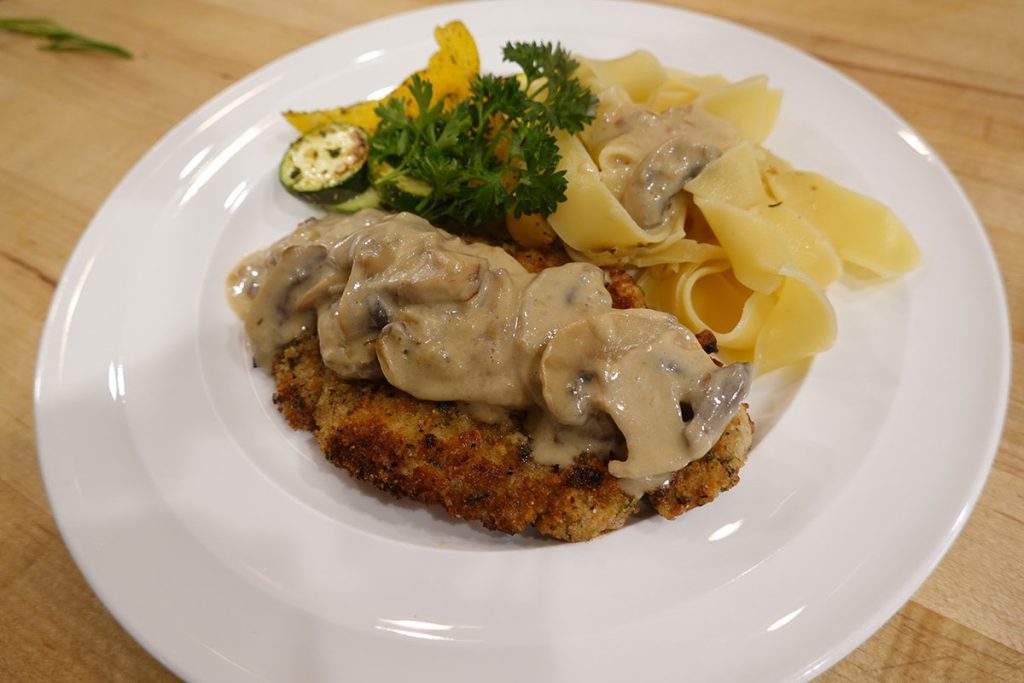Simple treatment for a classic dish
This season we tagged out early in the day of our prairie mule deer hunt––so early in fact we lined up a pheasant hunt in the late afternoon. What follows is a simple treatment for pheasant breasts to be substituted for schnitzel normally made with pork. If you have no pheasant and want to substitute ruffed grouse breast, that would be fine, but you will likely want two pieces of breast per diner.
Pheasant is a lean dense white protein that makes a perfect schnitzel. The optional mushroom sauce is an excellent accompaniment to the pheasant and kicks the egg noodles up a notch on the plate.
This would make a fine dinner for hunting camp, or a celebratory dinner at home to share your hunting success with your family.
Equipment
Cutting board
Boning, slicing, and chopping knife
Measures
Saucepan
Cast iron frying pan
Wooden spoon
Meat Mallet or cleaver for flattening cutlets
Stovetop
3 bowls or containers for breading process
Whisk
Pheasant schnitzel with mushroom sauce.
This recipe serves two.
Ingredients
For schnitzel
2 Pheasant breasts (from one bird)
50/50 blend of coarse salt and coarse pepper for seasoning
2 + 1 tablespoon of butter
1/2 cup all-purpose flour (for dredging)
1 egg
1/4 cup milk
1/2 cup fine breadcrumbs seasoned with Italian seasoning or herb mix, salt and pepper
2 tablespoon canola oil for searing the cutlets
1 bunch fresh parsley to chop and add to breadcrumbs and to use for garnish
For Mushrooms sauce
1 shallot, peeled and finely diced
1 cup of sliced fresh mushrooms
2 tablespoons butter
2 tablespoons all-purpose flour
White wine
60 ml / 1/4 cup heavy cream (35% whipping cream is perfect)
Method
Prepare the schnitzel.
Remove skinless breast meat from the pheasant and wipe the meat with paper towels to ensure the surface of the meat is dry.
Place the pheasant schnitzel between two sheets of plastic wrap on a solid surface and smack with a cleaver or meat mallet to make a 1/2 centimetre or 1/4-inch-thick cutlets.
Sprinkle cutlets with coarse salt and pepper. Let rest for at least 15 minutes while you assemble the sauce.
Prepare three separate bowls or containers for breading the pheasant: flour, egg and milk, and breadcrumbs.
Make the sauce.
Melt butter in the saucepan over medium heat.
Add diced shallots and cook until translucent.
Add mushrooms and cook until lightly browned.
Add the flour and stir to combine with the butter.
Cook for a few minutes while stirring every minute.
Add wine and cream and whisk into the flour and butter mixture to eliminate lumps.
Bring to a boil, then reduce the sauce to a simmer.
Cook the schnitzel.
Heat the frying pan over medium heat and add canola oil with a tablespoon of butter.
Dunk the pheasant breast in flour to cover well, then into the egg and milk mixture to coat, then into the breadcrumbs.
Gently push breading into the schnitzel and shake off excess before adding to the frying pan.
Cook for 3-5 minutes until the breadcrumbs are light brown, turn and cook another three minutes until the breadcrumbs are browned.
Serve immediately over your choice of noodles or potatoes.
Top with mushroom sauce.
My wife Kathy pronounced the pheasant schnitzel delicious at the first bite. She said I would redo this any time. Now I just wish pheasant season was still open.

